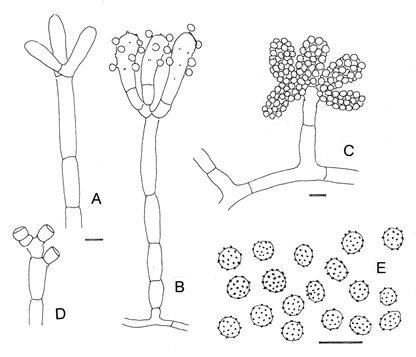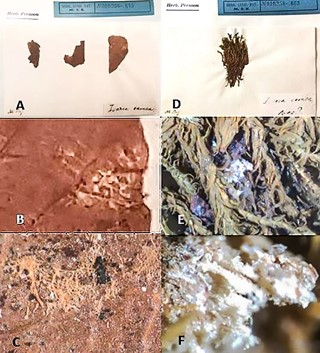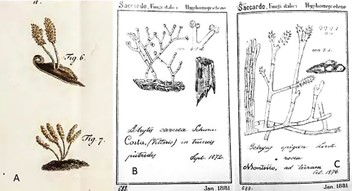Chromelosporiopsis carnea (Schumach.) Hennebert
MycoBank number: MB 835623; Index Fungorum number: IF 835623; Facesoffungi number: FoF14396;
≡ Botrytis carnea Schumach., Enum. Pl. 2: 238, 1803, nom. sanct.
= Isaria carnea Pers., Ann. Bot. (Usteri) 15: 13, 1795; Syn. Meth. Fung. 2: 689, 1801.
≡ Chromelosporium carneum (Pers.) Hennebert, Persoonia 7: 196, 1973.
= Polyactis carnea Ehrenb., Sylv. Mycol. Berol. 25, 1818.
≡ Mucor carneus (Ehrenb.) Link, Spec. Plant., ed. 4, 6(1): 88, 1824, nom. illeg., non Schaeff. 1774
≡ Botrytis carnea (Ehrenb.) Spreng., Syst. Veg., ed. 16, 4(1): 551, 1827, nom. illeg., non Schumach. 1803.
≡ Sporodinia carnea (Ehrenb.) Wallr., Fl. Crypt. Germ. 2: 317, 1833.
≡ Ostracoderma carneum (Ehrenb.) S. Hughes, Canad. J. Bot. 36: 792, 1958.
= Botrytis rosea Link, Mag. Ges. Naturf. Freunde Berlin 7: 36, 1815, nom. illeg., non DC. 1805.
= Botrytis linkii Duby, Bot. Gall, 2: 919, 1830 [as “linckii”].
≡ Ostracoderma linkii (Duby) S. Hughes, Canad. J. Bot. 36; 792, 1958.
= Campsotrichum splendidum Schwein.,Trans. Amer. Philos. Soc., n.s. 4: 283, 1832.
≡ Botrytis splendida (Schwein.) Sacc., Syll. Fung. 4: 123, 1886.
= Rhinotrichum opuntia Berk. & Broome, Ann. Mag. Nat. Hist., ser. 2, 13: 462, 1854.
= Botrytis carnea f. foliicola Roum., Fungi. Sel. Gall. Exs., Cent. 14: no. 1367, 1881.
Types—Polyactis carnea Ehrbg.[scr. Ehrenberg] on leaves of Fagus sylvatica, Herb. Schwaeningrichen (STR) (MBT 392408, here designated as lectotype [DAOM 83897, MUCL 2440]). Polyactis carnea Ehrbg. [scr. Ehrenberg] on leaves of Fagus sylvatica, Herb. Nees (STR) (Isolectotypes: DAOM 83896, [MUCL 2439]; Herb. Persoon (L 910-262-747) [MUCL 2464]).
Chromelosporium carneum (Pers.) Hennebert on leaves of Quercus pedunculata and Fagus sylvatica, Forest de Soignes, Tervueren, Belgium, Aug. 18 1960, leg. G.L. Hennebert (Epitype: MUCL 1208, designated as “neotype” by Hennebert, 1973; isoepitype: DAOM 74697).
Colonies superficial, fast growing and evanescent, in scattered tufts of hyphae, 3−15 mm wide, 15−2 mm high, comprising ≤15 erect divergent synnemata bearing conidia in their upper half, white when young, flesh-colored when mature on the field, ochraceous salmon when dried. Hyphae repent, sparse, delicate, hyaline to ochraceous, single or aggregated, (9−)12−15(−23) µm wide, thin-walled, smooth, septate, branched, often anastomosing, with short cells. Synnemata arising from the basal mat of hyphae, erect columnar, ≤1.5 mm high, 50 µm wide, composed of ≤30 growing conidiophores.
Conidiophores stipes contiguous, 11−17 µm wide, anastomosing, septate at 50−80-µm intervals, thin-walled, smooth, slightly bent outwards laterally and apically in the upper half of the synnemata and branching in a coralloid pattern of asymmetric dichotomies, one branch of each dichotomy developing first and sometimes becoming septate at the base, Conidiogenous head formed of 4−9 last successive bifurcations, the branches being 15−50 × 6−10 µm, apically obtuse, slightly clavate, 7−12 µm wide and often bent, all branches conidiogenous, forming an isarioid head.
Conidia holoblastic, borne simultaneously on denticle 1 × 0.5 µm, 5−11 µm distant from each other, one-celled, globose, occasionally subglobose, 4.8−6.6(−7.8) µm (most 5.4–6 µm), walls 1−1.5 µm thick, the inner wall ochraceous, the outer wall cyanophilic and coarsely verrucose, bearing 8−12 rounded warts in median view, seceding rhexolytically.
Habitat: on dead leaves of Fagus sylvatica and Quercus pedunculata, also on other leaves, bark, mosses, and organic debris on soil, in forests, from August to October.
Distribution: Europe: Austria, Belgium, France, Denmark, Germany, Great Britain, Netherlands, Sweden.
Comments—The earliest description and illustration of Chromelosporiopsis carnea is by Persoon (1795) under the name Isaria carnea, with conidiophores sticking together (“conferta”), at first white, then flesh-colored (“primo albida dein carnea”) and evanescent (“evanescens”), illustrated in Persoon (1796: Observ. Mycol. 1, tab. 2 figs 6-7) by fine color paintings (Fig. 15A). The authentic specimens of Isaria carnea in Persoon’s herbarium, signed by Persoon but with no date, are here documented by the excellent photographs made by Dr Nuytinck and M. Scherrenberg in Leiden (Fig. 14). Schweinitz (1832) showed that Isaria carnea has fascicles of hyphae (synnemata) diverging from a shared base, pale brown, apically floccose and bearing abundant fleshy-red spores (‘sporulis carneo-rubris’) spread along the hyphae. Isaria carnea was treated by Fries (1832a,b) as a synonym of Dactylium macrosporum Fr., nom. sanct. [≡ Botrytis macrospora Ditmar, nom. illeg.], but it is really a different fungus, and and its epithet is therefore potentially available for use. However the epithet is not truly available, as Fries (1832a) accepted and sanctioned the species under the name Botrytis carnea based on Schumacher’s description and his examination of Ehrenberg’s specimens of Polyactis carnea.
Botrytis carnea is described as “cespitosa, stipitibus brevissimis, dichotomis, ramosissimis, albidis, sporulis congestis spicatis carneis; in lingo putrido Betulae albae, Septembr,” while Polyactis carnea shows “floccis suberectis dichotomis capitatis albis, sporidiolis primum albis, dein carneis, globosis. In foliis pinorum. Pluvio freq. In fossis. Septembr.” As neither Schumacher nor Ehrenberg cited Persoon, they are two distinct names for the same species, not obligate synonyms. As the name Botrytis carnea is sanctioned it must serve as the basionym for the species as understood here.
No original material of Botrytis carnea is available, but three good specimens collected by Ehrenberg and preserved in STR and L under the name Polyactis carnea contain synnemata, bifurcate branching hyphae, and verrucose conidia.
Campsotrichum splendidum Schwein. n° 2695 is described with synnemata (“coalitis floccis”), furcate branches emerging along the upper half, and bearing reddish orange verrucose conidia (“pulcherrime decorate”). This is a possible synonym of C. carneum.
Saccardo (1881) illustrated Botrytis carnea (Fig. 15B) as mononematous and dichotomous with verruculose, rose-isabella conidia without indication of synnemata. However, he drew synnemata and asymmetric bifurcations in Botrytis epigaea var. rosea, another synnematous Chromelosporium-like taxon (Fig. 15C). Saccardo (1886) also described B. carnea var. quercina with smaller conidia, 4.5−5 µm, asperulate and rose-colored. Both of these varieties show characters of C. coerulescens.
Specimens examined.
Authentic specimens: EUROPE: (5), Isaria carnea [scr. Persoon] on leaves of Fagus leaves, Herb. Persoon (L 910-258-645). (6) Isaria carnea var? [scr. Persoon] on a patch of moss. Herb. Persoon (L 910-258-663) [the specimen bears immature smooth conidia]. Germany, (7) Botrytis rosea Link, on small pieces of leaves of Fagus sylvatica, Rostock. Herb. Link (B) [DAOM 51764, MUCL2451]. UK, (8) Rhinotrichum decolorans Forden, on cupules of Fagus sylvatica, Forden 312. Herb. M.C. Cooke 1885 (K-M) [MUCL 3495].
Other specimens: EUROPE, UK (9) Phymatotrichum, on bare soil and dead leaves, Ashridge, Herts., England, July 17 1955, D.A. Reid (K-M) [MUCL 2304]. (10) Phymatotrichum sp. on soil and vegetable debris, Windsor Great Park, Windsor, Oct. 3 1962, D.A. Reid & R. McNabb (K-M) [MUCL 3133, MUCL 3494]. (11) Botrytis carnea, on Epilobium hirsutum, Witham Park, Oxfordshire, Sept. 17 1949, M.B. & J.P.Ellis (K-M−IMI60211) [MUCL 3517]. (12) Botrytis aff. splendida Schw., on mossy Salix bark, Wheatfen Broad, Nrf., M.B. Ellis (K-M−IMI 26983) [MUCL 3568]. (13) Phymatotrichum sp. on petioles of Petasites ovatis, Masham, Yorks., Oct. 13 1947, S.J. Hughes (K-M−IMI 19231b) [MUCL 3572]. (14) Phymatotrichum, bark of Quercus, Kinclaven, Perthshire, Sept. 1953, M.B. Ellis (K-M−IMI63926) [MUCL 3505]. (15 Phymatotrichum sp., on bark and earth in a deep hole, Ashridge, Hertford. July 17 1956, D.A. Reid, det. M.B. Ellis (K-M−IMI 60584) [MUCL 3520]. (16) Phymatotrichum sp., on rotten wood, Ruislip Woods, Oct.14 1955, C. Booth, det. A.H.S.. Brown. Herb.(K-M−IMI 61356) [MUCL 3523]. (17) Phymatotrichum, on moss on beach, Burnham, Beeches, Oct. 20 1956, A.H.S. Brown. (K-M−IMI 69690) [MUCL 3541]. (18) Phymatotrichum., oak and hazel leaf litter, Park Wood, Ruislip, Oct. 15 1949, P.K.C. Austwick (K-M−IMI 37957) [MUCL 3559]. (19) Chromelosporium carneum, decaying Quercus wood, Pett near Hastings, Sussex, Aug. 29 1965, P.C. Holland, det. W. Gams (MUCL 7929). (20) Chromelosporium carneum, on stem debris, Ashdown Forest, Forest Row, Sussex, Oct. 1 1967, D. Mitchell & P.C. Holland (MUCL 11290). Netherlands (21) Botrytis fulva Link ex Fr. on herbaceous stems under Fagus sylvatica. Bussum, Oct. 24 1929, W.J. Lütjeharms (L) [DAOM 83937, MUCL 2515]. Austria (22) Botrytis carnea Schum. ad folia et cortices putridos, sylvis umbrosis, autumno, L. Fuckel.. Fuckel Fungi. Rhen. Exs. 146 (G, K-M, GRO, NY) [DAOM 74694, MUCL 1808]. Denmark (23) Phymatotrichum, on leaves, wood and cupules of Fagus sylvatica, Gris Skov, Sealand, Oct. 2 1955, S.J. Hughes (DAOM 51702). (24) Phymatotrichum, on wood chips of Fagus sylvatica, Gris Skov, Sealand, Oct. 2 1955, S.J. Hughes (DAOM 51690). Poland🙁25) Botrytis carnea Schum., in trunco Juniperi, Eichler, in herb. Bresadola 184 (S) [DAOM 83948, MUCL 2532]. (26) Chromelosporium carneum, on rotten wood, Biatowiesga forest, Pologne, Sept.5 1966, W. Gams (MUCL 9298). (27) Chromelosporium carneum, on rotten wood, Augustow Reserve, Starozym, Pologne, Sept.3 1966, W. Gams (MUCL 9299). France (28) Botrytis fulva Link écorce de Quercus et Corylus, Lyon, Sept. 1879, J. Therry. C. Roumeguère Fungi Gall. Exs. (BR) [DAOM74695, MUCL 1809]. (29) Botrytis carnea. feuilles de chêne [Quercus] pourrissantes, Tassin, Lyon. Sept. 1880, Cryptogames du Lyonnais, J.J. Therry. 5092 (PAD) [MUCL 1870]. (30) Phymatotrichum, on mossy bark of Quercus, Forêt de Jupilles, France, Sept.15 1952, E.M. Wakefield, det. M.B. Ellis (K-M−IMI 50643) [MUCL 3598]. Belgium (31) Botrytis rosea Link, in foliis Quercus robur, coll. Libert (BR) [DAOM 74693, MUCL 1806]. (32) Chromelosporium carneum, on dead leaves of Fagus sylvatica and Quercus pedunculata in woods, Parc d’Arenberg, Hevelee, Sept. 1 1960, G.L. Hennebert (MUCL 1218, DAOM 74698). (33) Chromelosporium carneum, on twig of Fagus sylvatica, Parc d’Arenberg, Hevelee, Août 21 1964, G.L. Hennebert (MUCL 6278). (34) Chromelosporium carneum, on bare humid soil under Fagus sylvatica, in Lauzelle forest, Louvain-la-Neuve, Oct. 2017, G.L. Hennebert (MUCL 56651).

Fig. 6. Chromelosporium canadense (holotype, DAOM 71947). A. Conidiophores at low magnification. B-D. Young stages of conidiogenous cells. C. Half and fully mature conidioma. E. Wide angle of the dichotomies. F. Terminal bunch of mature conidiogenous cells.

Fig. 7. Chromelosporium arenosum (holotype, DAOM 83359). A. Young conidiophore branching. B. Erect conidiophore with conidiogenous cells. C. Mature conidiophore with conidia borne on aerial hypha. D. Conidiophore after secession of conidiogenous cells. E. Conidia. Scale bar = 10 µm.

Fig. 12. Chromelosporiopsis carnea. A Synnemata (MUCL 1806) .B. Coralloid branching of the conidiophores. C. Conidiogenous cells. D. Verrucose conidia (B-D, isolectotype MUCL 2464). Scale bar = 10 µm.

Fig. 13. Chromelosporiopsis carnea, cluster of synnemata with isarioid conidial head (MUCL 6278).

Fig. 14. Authentic specimens of Isaria carnea Pers. A-C. Isaria carnea [written by Persoon]. A. Isaria carnea [written by Persoon]. A. Three pieces of Fagus leaves. B. Enlarged immature colony. C. Enlarged collapsed synnemata. D-F. Isaria carnea var.? [written by Persoon]. D. Patch of moss. E-F. Enlargements of a small patch of the fungus showing young white isarioid synnemata. (Photos J. Nuytinck and Dr M. Scherrenberg, Naturalis Museum, Leiden).

Fig. 15. A. Persoon’s illustration of Isaria carnea in Observ. Mycol. 1: tab. II, fig. 6-7, 1796. B-C. Saccardo Fungi Autografice Delineati (1881), fig. 688: Botrytis carnea Schum. and fig. 689: Botrytis epigaea var. rosea Sacc.
